People
Some People See the 1970s as a Golden Age of Contemporary Art. Charles Gaines Thinks Today’s Art Is Actually Much Better
We spoke with the artist as he prepared to open a show at Dia Beacon.
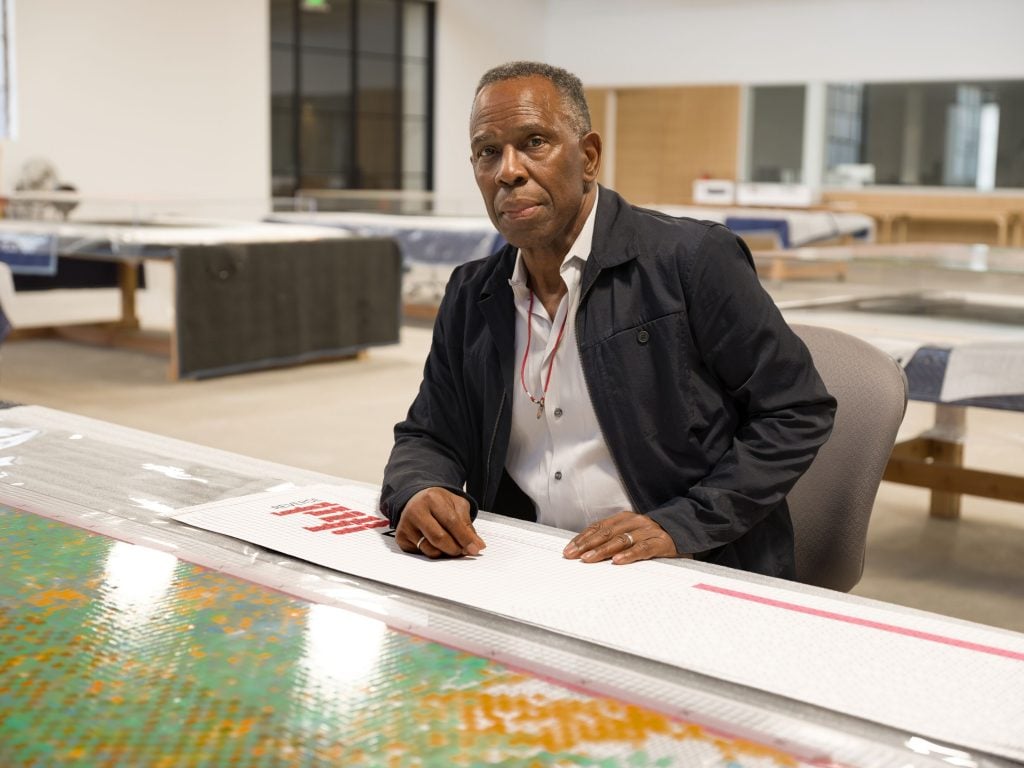
We spoke with the artist as he prepared to open a show at Dia Beacon.

Pac Pobric

It’s easy to get the wrong impression about the Los Angeles-based artist Charles Gaines’s pictures. On screens, the works look glitchy or digitized, even though they are painted painstakingly by hand. In person, many of his portraits look from afar as if they are solid—an impression that dissolves upon approach, as it becomes clear that they’re made of hundreds of tiny, vibrating, almost Pointillist dabs of paint, all set inside enormous grids.
That sense of instability—is this really what I thought it was?—is key to his work. For more than 50 years now, in ways both subtle and explicit, Gaines has been chipping away at the suggestion, born of the Enlightenment, that historical truths can be secured and made permanent. Most recently, he has been sharpening a new critique of identity, creating a series of works depicting individuals who self-identify as coming from mixed racial heritage. (The works are on view at Hauser & Wirth in London through May 1.)
Like his earlier “Identity Politics” series, which he showed at Paula Cooper in New York in 2018, the new works fizzle and pop with nervous energy, which is not dissimilar from Gaines’s manner of speaking. A dialogue with him feels like a pursuit for specificity, as he seeks exact phrases to articulate his sensibility.
As Gaines prepared to open a show of historic works at the Dia Art Foundation in Beacon, New York, Artnet News caught up with him about racial politics in America, why deaccessioning is essential, and why, seemingly all of a sudden, everyone is interested in his work.
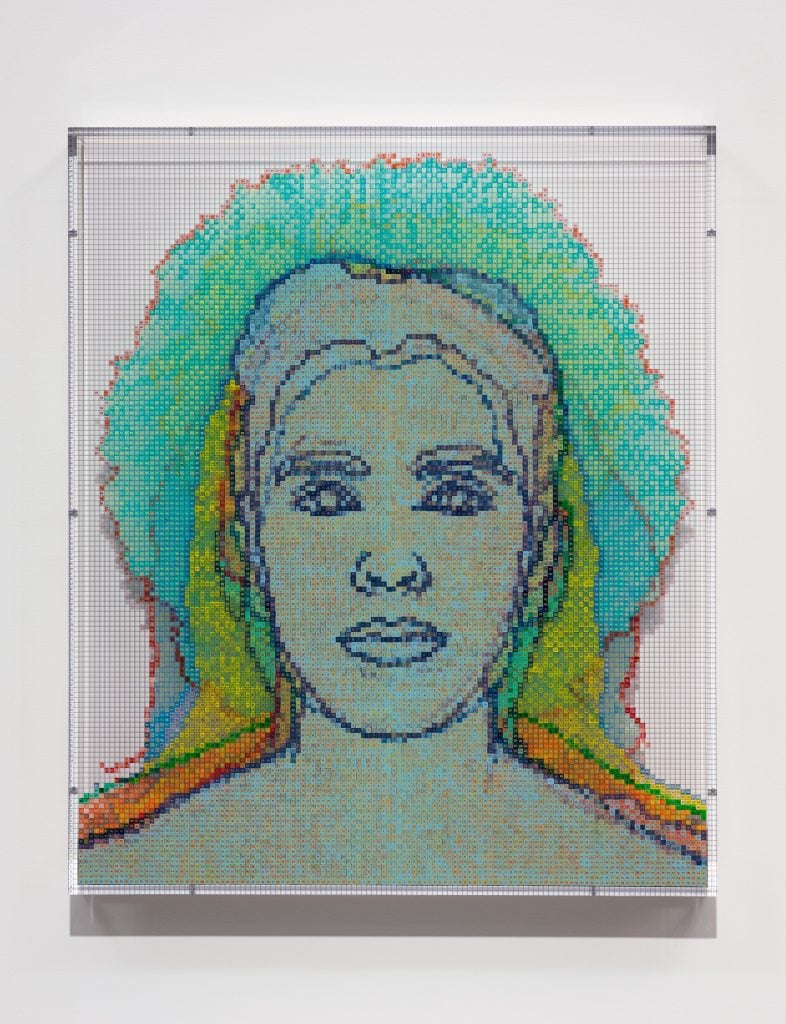
Charles Gaines, Numbers and Faces: Multi-Racial/Ethnic Combinations Series 1: Face #11, Martina Crouch (Nigerian Igbo Tribe/White) (detail, 2020). The works in this new series, on show at Hauser & Wirth in London, each depict people who self-identify as coming from mixed racial heritage. © Charles Gaines. Courtesy the artist and Hauser & Wirth. Photo: Fredrik Nilsen.
I want to ask first about your installation at the Dia Art Foundation, and the context for it. The museum is really a temple to a small number of artists: Donald Judd, Dan Flavin, Bruce Nauman, and so on. How might your work look different in that context than it might in another?
For me, it’s a perfect framework. I’m in the next generation of artists that they mostly feature. My professional practice started in the early ’70s, and many of the ideas that were being discussed in New York at the time were ideas that I was also involved in, even though—the way I look at it—I had a slightly different angle on those issues. Those [conversations] were essentially the last episode of the avant-garde. I’m a product of that legacy.
But in the 1970s, I didn’t get the profile that would make Dia interested in me. When I say profile, I mean wasn’t a famous artist [laughs]. But I wanted to be in that company. It was always appropriate. It’s just that I wasn’t important enough, for whatever reason. But they’re repositioning me, and there’s this general thing of repositioning me as a pivotal figure of this period.
It’s interesting that you say that they are repositioning you, because in some ways, it seems like Dia is repositioning itself. As you say, you fit into Dia’s context years ago. Have you thought about whether the recent interest in your work is related to recent events in the US? Have those affected how you’ve been received?
I do think that there has been a political awakening. One of the things the Obama administration showed is the existence of an entrenched right wing in the United States. The election of a Black president called out the Klan, big time. But I think an awakening was going on before that, and I benefited from that, and am still benefiting from it.
I wonder if it’s not more the museums and the public that benefit. Both are learning that they stand to gain a lot from a broader history of Modern art, because it’s been a pretty narrow field for a long time.
I agree with you. I think culture in general benefits. Somebody asked me recently, what do I think about contemporary art discourse? How does it compare with the discourse of the ’70s? I said, that’s easy: the art discourse of the 1970s was very narrowly inscribed and much less interesting than today. It’s now coming from a more more multicultural field, which includes political discourse as part of a critique of art—which it didn’t back then. I think art in general got more interesting and better. A lot of people say you can’t compare different ages. But I lived through that period and I’m living through this one. And it’s way more interesting and complex than it was then.
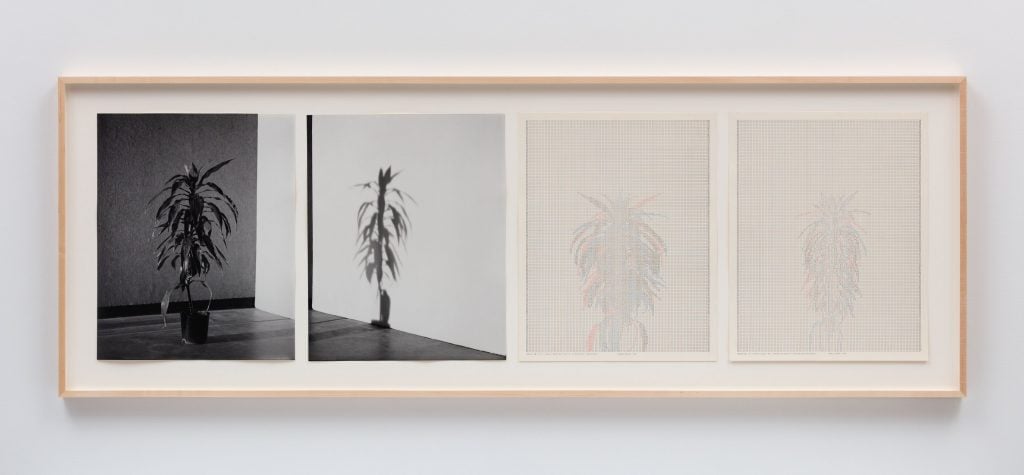
Charles Gaines, Shadows IX, Set 3 (1980). In works made earlier in his career, such as in the “Shadows” series, Gaines’s political sensibility had yet to emerge. © Charles Gaines. Photo: Fredrik Nilsen, courtesy the artist and Hauser & Wirth
In terms of how you fit into Dia, an obvious difference between your work and Flavin’s or Judd’s or Nauman’s is your political sensibility. Was that part of the reason the museum wasn’t interested in your work in the 1970s?
No, because my work of that period was not political. [Politics] really entered my work a decade later. To the world, it just looked like my use of grids and numbers was a continuation of the conceptual enterprise—and it took me a little while to understand the politics of that.
My work just couldn’t get past a certain level of interest. As you can probably tell from my resume, I was being represented by the most important galleries [Leo Castelli, John Weber, and Margo Leavin were among Gaines’s dealers in the ’70s]. But I reached a ceiling where I couldn’t get writers to write about me and curators weren’t interested in putting me in shows. The way I look at it, if I had got a bigger public profile, then I think Dia would have been interested. It’s clearly not a factor that they saw my work politically at that time.
Since then, though, your work often has been distinctly political. In 2018, you made the “Identity Politics” series, in which you juxtaposed images of a very diverse range of political figures—including bell hooks, Michel Foucault, and Aristotle—against one another. That struck me as a very structuralist way of thinking: you take disparate things—people, in this case, with varying and often conflicting political ideals—present them together, and see what kinds of similarities and differences you get. Would you call yourself a structuralist?
I wouldn’t call myself a structuralist, but I studied structuralism, deconstruction, and semiotics intensively. Those general ideas are very influential. The general notion is that it doesn’t matter what two figures you sequence next each other, because there’s a story to be told no matter what. Ultimately, meaning is going to be produced because of our cultural knowledge. The role of the spectator becomes very significant in that process.
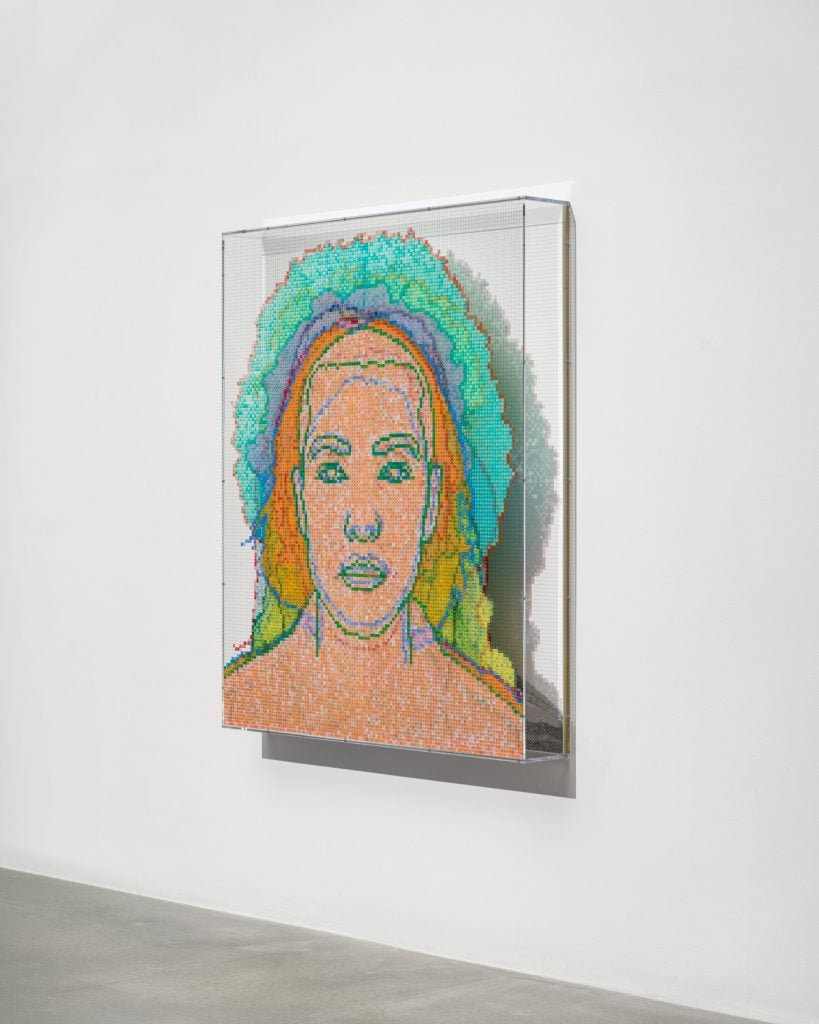
Charles Gaines, Numbers and Faces: Multi-Racial/Ethnic Combinations Series 1: Face #16, Naoki Sutter-Shudo (Japanese/French/Swiss German) (2020). Like many of Gaines’s works, the ones in this series are made atop and within a Plexiglas-like box. © Charles Gaines. Courtesy the artist and Hauser & Wirth. Photo: Alex Delfanne.
You’re talking about arbitrariness and meaning—no matter what you do, some meaning is bound to emerge. But you still make certain artistic decisions, right? One series you’re showing now at Hauser & Wirth in London depicts people who self-identify as being of mixed racial heritage. You did have to decide to make that the focus of the work.
I am not arguing that subjectivity or intuition or creative invention don’t exist. Nor am I arguing that they’re unimportant to experiencing a work of art. What I am saying is that most people think that when you make a choice, you’re expressing yourself. But my position is that making a choice is not an act of expression.
I make choices the way a scientist does, and we don’t say that scientists make works of art, because there’s an element of rationalism that goes into scientific choice-making. I have another example: playing chess. There are an exponential number of choices you can make in chess, and nobody calls those decisions subjective. I’m creating or inventing a machine in the way that all other people in all other circumstances invent or create. There’s no reason to separate art and artists from all kinds of other activities.
There’s another part to this, which is that I wanted to undermine universal notions. That came out of my lived experience as a Black person. If you’re Black, or if you look Black, there is a different set of rules than if you’re white. Being white has been [considered] a universal expression of humanity, and racism played into that by marginalizing people who are not white. Once you universalize the idea of race, you make it into a system, a basic framework of operating. What the Enlightenment did was construct a universal idea of race that couldn’t be critiqued because it was said to be natural. That’s the bigger picture I was interested in critiquing.
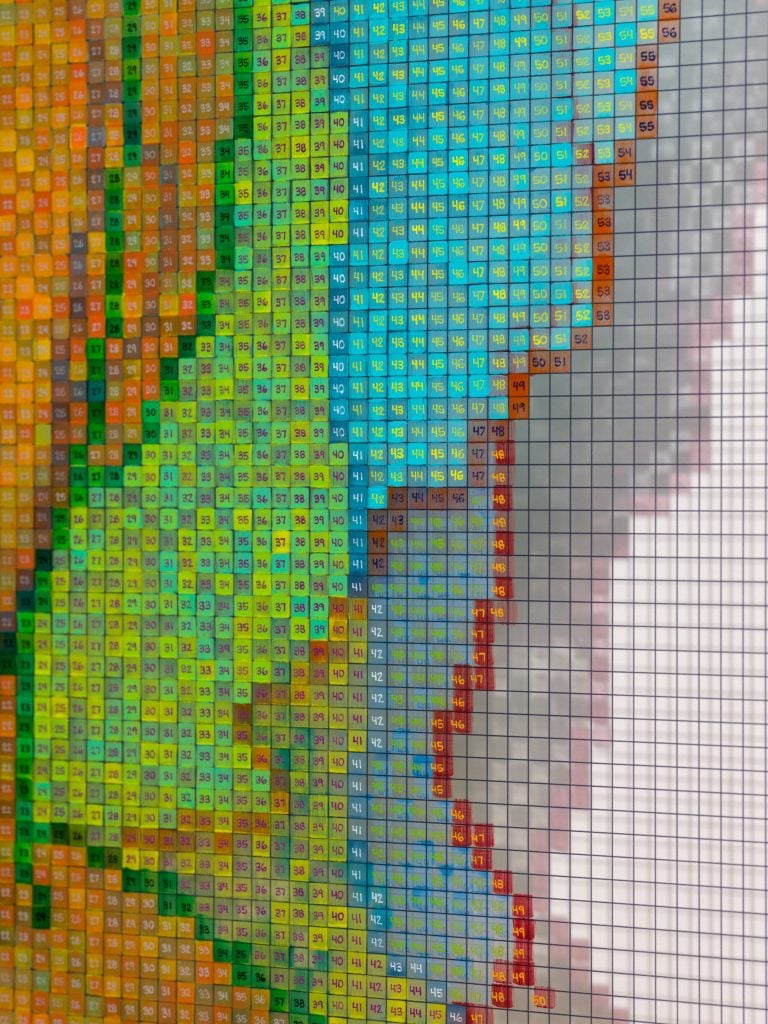
A detail from Charles Gaines’s Numbers and Faces: Multi-Racial/Ethnic Combinations Series 1: Face #7, Eduardo Soriano-Hewitt (Black/Filipino) (2020). Gaines painstakingly fills out sections of grids to create fuller portraits in many of his pictures. © Charles Gaines. Courtesy the artist and Hauser & Wirth.
In terms of the bigger picture, you mentioned on a podcast recently that you’ve been involved in discussions with museums about deaccessioning to diversify collections. In what cases would you find it acceptable or unacceptable to do so?
I get into arguments with my progressive friends about this: I feel that deaccessioning for the purposes of diversification is always legitimate. History is something that I value greatly. But one of the things that’s part of the history of art is that its discourse was racist, and that should be acknowledged. Deaccessioning is one way to do that. It’s saying: We have an opportunity to comment upon history by critiquing the way this particular narrative was formed. For me, that’s dealing with history as a living agent.
It’s like this argument that’s going on now in Congress about getting rid of the filibuster to pass bills. People say you can’t do it, because it’s a cherished hallmark of Congress. Well, that’s true, but it was [used] to [perpetuate] Jim Crow laws. To pretend it transcends those uses is foolery to me.
What about the argument that the real problem with deaccessioning is taking works of art out of the public realm?
That’s simply articulating the same argument, that history can’t be reconsidered. You could make the argument that a Clyfford Still painting is one of the greatest in the history of abstraction, and that he’s a genius and we have to reserve a spot for him. And I agree—when I was in graduate school, I loved him and thought he was great.
But the problem is that the reason he’s called a genius is that he played in a much more limited field. There wasn’t much competition. It’s not to say his painting stinks [laughs]. The painting is still great! It’s wonderful. But cherishing his space reinforces the idea that historical judgement is infallible.
“Charles Gaines” goes on view at Dia Beacon on February 19. “Charles Gaines: Multiples of Nature, Trees, and Faces” is on view at Hauser & Wirth in London through May 1.